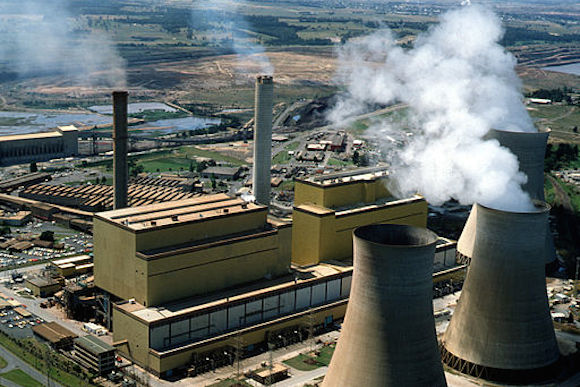Climate policy? It’s one for the brave…..
Tough issues often fail to make it onto the agenda. In a close-fought election, no one wants to be brave unnecessarily. Once a few key focal points are defined – health, transport, education, and law and order are predictable candidates in State elections – and antlers are locked in combat, why add to the pain and uncertainty of the contest?
If the parties actually have relatively similar policies in a contentious area, it’s also best to keep stumm. Without a clamorous public pushing to know, a quiet consensus emerges in the back rooms – it’s best to let sleeping dogs lie.
Climate change is one of those issues in this state election. With less than a fortnight to go to the 2014 election, there’s only been one feint at the issue so far (Labor has promised to reverse planning restrictions on new wind farms).
As we’ve seen in recent times, climate policy asks a lot of any government that wants to do something significant. It is vitally important if we are to see this state – and Australia - contribute fairly to a global effort to combat climate change. Victoria produced around 129 million tonnes of CO2 (equivalent), or only a little under a quarter percent of Australia’s total emissions, in 2012.
But being effective involves some tough decisions, with clear winners and losers. Therefore the politics of climate can be divisive - as the bruising battles over the carbon tax have shown. Those politically brutal encounters seem to have disciplined everyone to keep their heads below the parapet.
Yet potentially this issue also could be decisive in a handful of marginal seats, especially for Labor if it wants to hold off the Greens, or to overwhelm the Liberals.
During the time of the Rudd Government, the states were keen to hand responsibility for action on emissions mitigation to Canberra, to be pursued through national policy using a carbon tax or emissions trading scheme. Despite the turbulence of those years, with the re-election of the Gillard Government in September 2010, state governments of all persuasions hoped and believed they could now confine themselves to thinking about adaptation.
Even so, when the Liberals won government in Victoria four months later, in November 2010, they inherited a relatively well-defined institutional and statutory basis for state-level climate policy – both mitigation and adaptation.
Labor under Brumby had passed the Climate Change Act and – reluctantly - legislated a modest Victorian emissions mitigation target of -20 per cent below 2000 levels by 2020. It established a generous feed-in tariff that propelled the uptake of renewable energy by households, and drove investment in wind and solar power - creating jobs. Labor supported the uptake of solar hot water with a rebate. Labor also aimed for 5 per cent of Victoria’s power to come from solar energy, and 10 percent of all energy from renewables, by 2010.
The Brumby Government also established institutions to provide it with bureaucratic, independent scientific, community-based, and academic advice – a dedicated unit within Premier’s and Cabinet, the Premier’s Climate Change Advisory Panel, a Ministerial Reference Group on Adaptation, and VCCCAR – the Victorian Centre for Climate Change Adaptation Research.
These achievements were counterbalanced by some notable failures – which reflected deep ideological divisions within Labor. Labor had also extended the life of one of the world’s dirtiest coal-fired power stations – Hazelwood – and courted the idea of enabling the export of brown coal from the Latrobe Valley.
Since the Liberals came to power Victorian climate policy has been in freefall. The Liberals:
- Abandoned the Climate Change Act and changed its legislated mitigation target of -20 per cent to -5 per cent by 2020
- Dismantled critical institutions for climate policy planning and advice
- Placed planning restrictions on new wind farms, which discouraged investment in that industry and made further development almost impossible
- Set aside Victoria’s Renewable Energy Target – Victoria now has no targets for renewables
- Reduced the feed-in tariff – a major incentive for households to invest in solar energy – from 60c/Kw to 25c/Kw and then to 8c/Kw – and reduced access to the new tariff, and
- Promoted the development of brown coal for export, spending some $70 million in trying to make this an attractive proposition.
Within the space of only three years, Victoria has gone from being a climate leader to laggard among Australian states and territories.
For instance, although renewable energy comprises 12 per cent of total energy in Victoria, the percentage of households with solar PV lags behind almost all other states – it is only slightly more than Tasmania and the Northern Territory, and its rate of growth has fallen dramatically. The Climate Council claims that Victoria now ‘has the worst policy on renewables in the country’.
Meanwhile, fitful state-level negotiations with the owners of Hazelwood, for the closure of the Victoria’s most ancient and dirtiest power generating plant, ceased when the Liberals came to power.
As the IPCC’s recent Fifth Assessment Report underlines, this issue won’t go away anytime soon. Strong climate policy is crucial for Victoria to prepare it for tougher mitigation pressures in the future, and to increase the state’s resilience against the now inevitable impacts of global warming… bushfires and storms, heat waves and drought.
National climate policy too is in freefall. The carbon tax has been axed and replaced by Coalition’s ‘Direct Action Plan’. The new plan is voluntary, underfunded and probably inadequate to the task of meeting Australia’s weak 5 per cent national emissions reduction target, let alone something tougher. The national Renewable Energy Target remains under threat, as is the Clean Energy Finance Corporation (although safe for the moment).
Given its recent turbulent history, we need to weather-proof climate policy against political storms, against the apparent likelihood that one or other political level will – for a time - fail to deliver. Our multilayered federal system provides us with an institutional means for building climate policy security. So what should one hope for, or look for, now?
Substantial mitigation effort by sub-national governments is a political and practical necessity. It has also been a notable success overseas. The United States – which for more than a decade has suffered a political logjam over climate policy in Congress – has seen its emissions drop, in part through the powerful action of leading states such as California to introduce tough targets, introduce emissions trading, regulate emissions in the energy and transport sectors, pursue energy efficiency measures, and facilitate the uptake of renewables.
Victoria needs a new Climate Action Plan. The question is, which party is game to provide it. Such a plan would need to contain crucial measures to be preserved in legislation – through amendments to the slumbering Climate Change Act - including mitigation targets that are scientifically robust and achievable - at minimum, -20 per cent below 2000 levels by 2020, and -40 per cent below 2000 levels by 2030.
Victoria could achieve the initial target by closing its dirtiest power generators at Anglesea, Hazelwood, and Yallourn. It could accompany such measures by establishing a Renewable Energy Target of 25 per cent by 2020.
In the mid-2000s the states, under Labor Governments, proposed a nationwide emissions trading scheme in the absence of federal action. Victoria could again cooperate with South Australia and other willing states to begin such a scheme.
Such a mechanism would help fund the rapid decarbonisation of the Victorian economy through assisted investment in energy efficiency measures, public transport and a well-defined parcel of additional measures of the sort that have now been seen to succeed in progressive countries and states overseas.
Environment Victoria, for instance, is campaigning for one million houses to be retrofitted by 2020. These latter changes would lower emissions while driving investment and increasing net employment.
Moreover, there would need to be a commitment to end further coal allocations and to ban the export of brown coal from Victoria – to stop the displacement of ‘our’ emissions to some other place.
These would be solid steps toward strong climate action. They would be contentious but, overall, probably popular. Perhaps an announcement of such scope and ambition is waiting in the wings, a surprise for the last week of campaigning.
It would be a welcome sign that this state has champions for its future. It would be, without a doubt, a policy announcement that would signal courageous and insightful leadership. It’s one for the politically brave.
Dr Peter Christoff teaches and researches climate politics and policy in the Department of Resource Management and Geography. He is currently on the Board of the Australian Conservation Foundation and was formerly a member of the Victorian Ministerial Reference Council on Climate Change Adaptation and the (Victorian) Premier's Climate Change Reference Group.
*Story image courtesy of CSIRO



